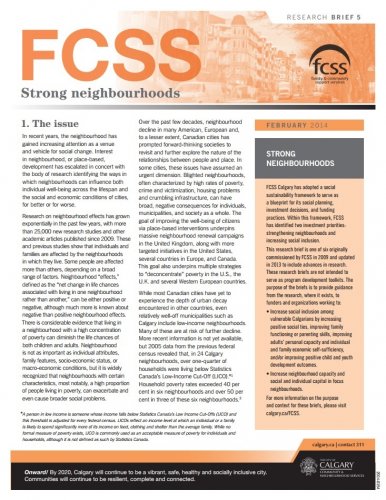In recent years, the neighbourhood has gained increasing attention as a venue and vehicle for social change. Interest in neighbourhood, or place-based, development has escalated in concert with the body of research identifying the ways in which neighbourhoods can influence both individual well-being across the lifespan and the social and economic conditions of cities, for better or for worse.
Research on neighbourhood effects has grown exponentially in the past few years, with more than 25,000 new research studies and other academic articles published since 2009. These and previous studies show that individuals and families are affected by the neighbourhoods in which they live. Some people are affected more than others, depending on a broad range of factors.
Neighbourhood “effects,” defined as the “net change in life chances associated with living in one neighbourhood rather than another,” can be either positive or negative, although much more is known about negative than positive neighbourhood effects. There is considerable evidence that living in a neighbourhood with a high concentration of poverty can diminish the life chances of both children and adults. Neighbourhood is not as important as individual attributes, family features, socio-economic status, or macro-economic conditions, but it is widely recognized that neighbourhoods with certain characteristics, most notably, a high proportion of people living in poverty, can exacerbate and even cause broader social problems.
Download Strong Neighbourhoods
Table of Contents
1. The issue
2. Neighbourhood effects: What are they and how do they work?
2.1 Evidence of neighbourhood effects in Canada
2.1.1 Child and adult health
2.1.2 Child development
2.1.3 Adult income and employment
2.2 Factors that cause or perpetuate neighbourhood low income in Canada
2.2.1 Neighbourhood stigma and isolation
2.2.2 Poor quality of and lack of access to amenities, resources, and services
2.2.3 Poor quality built and natural environments
2.2.4 Low levels of personal capital, social capital and social cohesion
3. Strengthening neighbourhoods
3.1 A brief summary of outcomes and learnings from large, neighbourhood revitalization schemes
3.2 Effective approaches to strengthening neighbourhoods: Lessons from Canada and around the world
3.2.1 Engaging residents and building neighbourhood capacity for change
3.2.2 Increasing neighbourhood cohesion and social capital
3.2.3 Mixed evidence on “social mixing”
3.2.4 Improving amenities, programs, and services
3.2.5 Community economic development
4. Strengthening Calgary neighbourhoods





